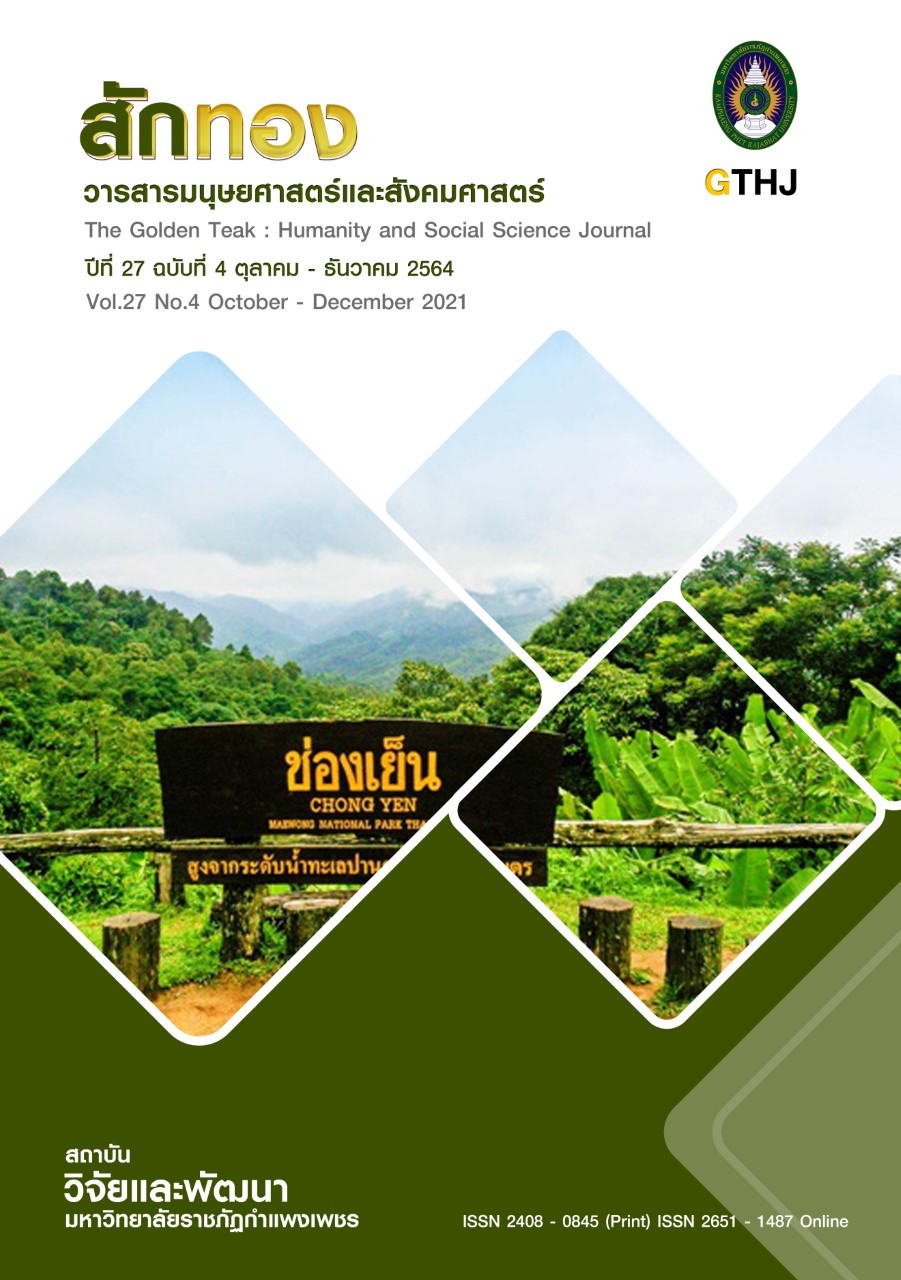Dancing to Enhance Executive Function Skill in the Early Childhood
Main Article Content
Abstract
ABSTRACT
Executive thinking is a high-level function of the frontal brain. In order to develop skills through an active learning activity. The development of Executive thinking skill should begin from early childhood. Because it is the time that the brain has the highest rate of growth. Creative dance activities are activities that encourage students to use dance moves following the music in order to train the brain to have the Executive thinking skill. Several researchers have studied this mentioned activity and found that creative dance activities can improve Executive thinking skill in the early childhood. This article aims to raise awareness of the importance of Executive thinking skill and to provide a guideline of using creative dance activities in the development of Executive thinking skills in early childhood. So that the children can grow up to become the qualified population of the country in the future.
Article Details
บทความที่ได้รับการตีพิมพ์เป็นลิขสิทธิ์ของวารสาร สักทอง : วารสารมนุษยศาสตร์และสังคมศาสตร์ สถาบันวิจัยและพัฒนา มหาวิทยาลับราชภัฏกำแพงเพชร
ข้อคิดเห็นใดๆ ที่ปรากฎในวารสารเป็นวรรณกรรมของผู้เขียนโดยเฉพาะ ซึ่งมหาวิทยาลัยราชภัฏกำแพงเพชรและบรรณาธิการไม่จำเป็นต้องเห็นด้วย
References
Caine, R. N., & Caine, G. (1994). Making connections: Teaching and the human brain. Menlo Park, Calif : Addison-Wesley.
Chartisthian, C., Meesomsarn, K. & Chaiyakan, A. (2017). Enhance discipline for early childhood. Bangkok : Pluspress.
Clancy, B. (2002). School readiness : Integrating cognition and emotion in a neurobiological conceptualization of children's functioning at school entry. American psychologist, 57(2), 111-127.
Clancy, B. (2016). Developmental science and executive function. Current directions in psychological science, 25(1), 3-7.
Chronopoulou, E. & Riga, V. (2012). The contribution of music and movement activities to creative thinking in pre-school children. Scientific Research, 3, 196-204.
Chuenrit, K. (2007). Self-Discipline development of young children experienced through music activities following His Majesty The King’s speech. Master’s thesis, Graduate School, Srinakharinwirot University.
Craine, D. & Mackrell, J. (2010). The Oxford Dictionary of Dance. (2 nd ed.). New York : Oxford University Press.
Fuster, J.M. (2015). The prefrontal cortex. Armsterdam : Academic Press.
Gilbert, A.G. (2015). Creative dance for all ages : a conceptual approach. (2 nd ed.). Champaign, IL : Human Kinetics.
Goldstein, S. & Naglieri, J.A. (2014). Handbook of executive functioning. New York : Springer.
Gothe, N. P., Keswani, R. K. & McAuley, E. (2016). Yoga practice improves executive function by attenuating stress levels. Biological Psychology, 121, 109-116.
Hanmethee, S. (2015). EF (Immune life and drug prevention). Bangkok : Rakluk Book.
Harvard University, Center of developing child. (2014). Enhancing and practicing executive function skills with children from infancy to adolescence. Cambridge : Harvard University.
Kaushanskaya, M., et al. (2017). The relationship between executive functions and language abilities in children : A latent variables approach. Journal of Speech, Language, and Hearing Research, 60(4), 912-923.
Kimberly, et al. (2016). Dancer perceptions of the cognitive, social, emotional, and physical benefits of modern styles of partnered dancing. Complementary therapies in medicine, 26, 117-122.
McGowan, J. (2018). What is creative dance? : Jennifer McGowan’s creative dance center. [Online]. Available : http://jvmcgowan.tripod.com/whatiscreativedance.html. [2020, August 30].
Miyake, A. & Friedman, N.P. (2012). The nature and organization of individual differences in executive functions: Four general conclusions. Current Directions in Psychological Science, 21(1), 8-14.
Pauls, L.J. & Archibald, L.M.D. (2016). Executive functions in children with specific language Impairment : A meta-analysis. Journal of Speech, Language, and Hearing Research, 59(5), 1074-1086.
Pantoon, N. (2011).The Results of movement activitives and applied hermit exercise (Rusie Dutton) rhythms for the physical development of preschool children.
Master’s thesis, Graduate School, Srinakharinwirot University.
RLG Institute. (2017). Executive Functions = EF. Bangkok : RLG Institute.
Rossberg-Gempton, I.V., Dicknson, J. & Gray, P. (1999). Creative dance : potentiality for enhancing social functioning in frail seniors and young children-Creative movement and older adults. The Arts in Psychotherapy, 5(26), 313-327.
Saengsawang, T. (2016). Executive Function: Scales and Development Guidelines for Elementary Students. Dissertation, Graduate School, Srinakharinwirot University.
Siriwanbutr, P. (2013). Developmental psychology theory. (6 th ed.). Bangkok : Chulalongkorn University Press.
Sriprasert, P. & Kheovichai, K. (2017). A Model of ballet dancing activity for enhancement an appropriate behavior of children with attention deficit hyperactivity disorder in primary education. Veridian E-Journal, Silpakorn University Humanities, Social Sciences, and Arts, 10(2), 2235-2249.
Thanomkitti, R. (2016). Effect of aerobic dancing program on preschoolers’ attention. Master’s thesis, Graduate School, Srinakharinwirot University.
Vissers, C., et al. (2015). Executive functioning in preschoolers with specific language impairment. Frontiers in Psychology, 6, 1-8.
Weiland, C., Barata, M. C. & Yoshikawa, H. (2014). The cooccurring development of executive function skills and receptive vocabulary in preschool-aged children : A look at the direction of developmental pathways. Infant and Child Development, 23(1), 4-21.
Ziereis, S. & Jansen, P. (2015). Effects of physical activity on executive function and motor performance in children with ADHD. Research in Developmental Disabilities, 38, 181-191.


